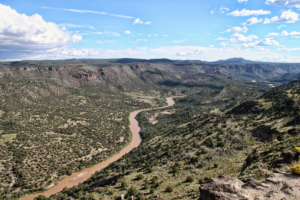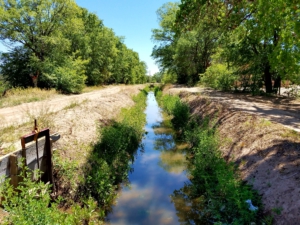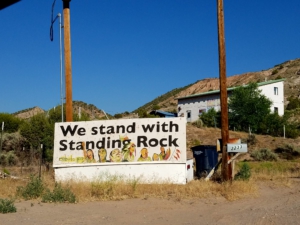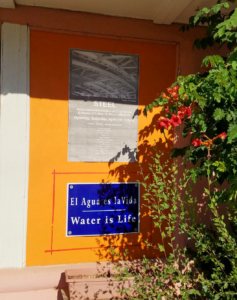
Indigenous and Latino communities have a long history of agriculture, irrigation and unique water systems here in New Mexico. From sacred springs to acequias, people have depended on water for their livelihoods in the desert for centuries, and their water systems contribute to their cultural identity. Water is the center of spirituality for many Indigenous peoples and a form of self-governance and democracy for Latino communities. Since the signing of the Treaty of Guadalupe Hidalgo in 1848, both Pueblo peoples and Latinos alike have been fighting against the U.S. government for the right to their water under the land grants they were promised to keep during the land secession from Mexico to the United States. As with many other signed legal documents of promises and agreements, the U.S. continuously broke the treaty and thus began a long history of illegal water seizure in the Southwest. Today, in the poor and rural communities of New Mexico, the descendants of these ancestral cultivators and resisters face threats from development, contamination and loss of water rights, all emanating from the grasp of capitalism.
Water transfers and adjudication

When a small-town farmer hears the terms “water transfer” or “adjudication,” suspicions and negative associations usually begin to plague their thoughts. This fear results from the long history of water theft and arduous court battles over water rights of small agricultural towns. Towns like Pecos, Taos, and Picuris Pueblo are pitted against large corporations, the state and U.S. governments. Water transfers are a change of place or purpose of use of water rights.(Water Transfers in the West: Efficiency, Equity, and Environment.1992. Ch. 7: Northern New Mexico: Differing Notions of Water, Property, and Community. National Research Council. National Academy Press. Washington D.C.) Since the end of World War II, the western U.S. has experienced rapid population and economic growth. New Mexico, a center of the country’s military-industrial complex and the site of the Los Alamos National Laboratory’s Manhattan Project and testing of the first atomic bomb, water transfers have been made to support this growth over the past few decades. More and more water has left agricultural communities and has been privatized and commodified for economic and large-scale residential development. For example, between 1982 and 2011, 21,000-acre feet of Middle Rio Grande water were transferred to Albuquerque and Santa Fe. Some of these transfers are from poor farmers selling their water rights to city governments or corporations, and some are transfers on behalf of the state, often without even consulting the affected community of the transfer first. The New Mexico Office of the State Engineer oversees transfers and adjudications and many farmers view the office with distrust.

Adjudication is defined as, “a legal proceeding in which the court hears and decides all water rights claims in the stream system and confirms any valid water rights, whether claimed by a plaintiff or defendant, by court order”. Although the process is said to be only acknowledging existing water rights, it is another tool that can be used by the government to take or withhold water from Indigenous and Latino communities. For example, since 2001, Zuni Pueblo has been involved as a plaintiff in a lawsuit with the United States government to adjudicate all surface and underground water rights in the Zuni River stream system. In a recently published report of this case, the court ruled that although the Zuni has existing rights to the waterways it is currently using, they do not have the right to increase water diversion in “excess of the maximum annual quantity of water lawfully diverted and used by the tribe prior to May 13, 1846”. This means that the tribe cannot use more water for its people or for its agriculture than what it was using 171 years ago, regardless of population growth or the Pueblo’s effort to revive traditional farming. In the rest of the ruling, the court continues to hold and limit Zuni to the frequency of resource use that the pueblo was using prior to the Treaty of Guadalupe Hidalgo. As it is, the Zuni River no longer reaches the Pueblo of Zuni as it is sucked dry by private ranchers further upstream and while Zuni is restricted in its growth and cannot further stimulate its economy through agriculture, the very center of Zuni culture and traditional practice, the state government continues to drain water from these marginalized, poor communities to feed its ever-growing greed for profit.
Contamination

With the military, nuclear research labs, and fossil fuel industry here in New Mexico, there are hundreds of examples of water contamination throughout the state. The majority of contamination sites surround impoverished communities and communities of color. The South Valley, a historically rural Latino center of Albuquerque, contains some of the most polluted areas of the state. Military giants Kirkland Air Force Base, Los Alamos National Laboratories (LANL) and Sandia National Laboratories (SNL) and other military installations like South Valley Works, a former nuclear engine research facility now owned by General Electric, have been dumping toxic waste around the Latino and African-American residential neighborhoods of Mountain View and John Marshall. The groundwater south of these neighborhoods is so contaminated that it will never be potable again, which led to the largest environmental lawsuit in New Mexico history. The military isn’t the only polluter in the South Valley. Local industries are just as toxic, with thirty-one Environmental Protection Agency (EPA) regulated polluting industries located in the Mountain View neighborhood alone. Mountain View now has the largest underground nitrate plume in the state, which contaminated sixty-three wells and affected the health of residents (Price, V.B. 2011. The Orphaned Land: New Mexico’s Environment Since the Manhattan Project. University of New Mexico Press.)
In fact, there are three EPA identified Superfund sites in the South Valley. One, a petroleum hydrocarbon plume from Chevron, the ATA Pipeline, and Texaco tank farms. Another is a creosote-soaking site for the Atchison, Topeka, and Santa Fe Railroad. The last, the Pronto PCB dump site, where a Texas company dumped waste oil containing PCBs, a carcinogenic chemical, into an unlined pit between 1980 and 1982. In 1979, two city wells were found to have traces of chlorinated industrial solvents along with twenty private wells that were found to contain benzene and trichloroethylene, among many other volatile and carcinogenic chemicals. The EPA was called in to help, but water clean-up did not begin until seven years after the initial discovery. It is now thirty years later, and the EPA is still working on cleaning up the water. During the 1980s, 70 percent of the South Valley’s residents were Latino, with almost 50% living far below the poverty level (Price, 2011).
A whole article could be written about the atrocities and environmental crimes committed in the South Valley. Thousands of people have been affected by contaminated wells, and clean groundwater is becoming scarce. South Valley is a clear and terrible example of environmental racism.
Development
Profit from development has always been a priority in New Mexico and that continues to be true today, as seen in the community of Rio Rancho. Rio Rancho, initially a suburb of Albuquerque, is now a separate city and continues to develop at an alarming and unsustainable rate, outgrowing its water rights and depleting its aquifer. With no other options for water, Rio Rancho has been buying off water rights from the farmers of Jemez and Zia Pueblos. Capitalizing on the poverty within the Pueblos, Rio Rancho has been offering significant sums to buy up water rights and with farmers not yielding enough money from their crops, they often have no other options than to sell and move away from their ancestral homes to the city to seek better opportunities.
Still, demanding more, Rio Rancho has considered a proposed pipeline that will run all the way from the San Augustin Plains in Catron County. Augustin Plains Ranch is a New Mexico corporation owned by foreign investors. The corporation’s plan is to drill thirty-seven wells near the town of Datil and pump 54,000 acre-feet of water each year through a pipeline to the highest bidder, until however long it takes to deplete the aquifer, completely forsaking ranchers and other residents of the area for profit. Rio Rancho in its hungry search for water, is one of the top contenders in this bid. Although right next to the Rio Grande, New Mexico’s main water source, Rio Rancho cannot use any of this water, as the river is already fully appropriated. Instead, with the drilling of the San Augustin aquifer, Rio Rancho will be “indirectly” sucking the Rio Grande dry by depleting one of the water sources that feeds into the river, which affects thousands of residents living south of Albuquerque that depend on the river for their livelihoods. This greed, thoughtless negligence, and complete lack of planning is just another characteristic of capitalism.
El agua es la vida – The fight back
New Mexico has a long history of water activism, and the fight continues today, now more imperative than ever. As climate change affects the landscape, more and more people struggle to hold onto their water rights as the competition for the scarce resource increases. Threats from the for-profit industry and from contamination plague the state as water associations impose stricter regulations and increase yearly water fees, forcing stakeholders to give up their rights because they either cannot afford it or because they live in the city and cannot make it back to their hometowns as often as they’d like to irrigate the fields that have been in their families for centuries. Even though Pueblo and Latino peoples have seniority within the court system when it comes to water rights, they clearly have the most to lose. This issue not only affects the descendants of these historic water users, it affects all poor people. New Mexico is the second poorest state in the country: 1 in 5 residents live in poverty (Santa Fe New Mexican). Sadly, local and state governments are not looking to make conditions better for the people. They bring in big companies like Intel and Facebook that suck the lifelines of the land dry and spew out toxic waste as a replacement – all at the cost of the people. The revenue from these corporations are not used for public education, healthcare, or affordable housing. All of it is funneled back into the pockets of the wealthy elite. We cannot rely on the Republicans or the Democrats to change these conditions, we must rely on ourselves. As long as capitalism exists, our rights will always be stolen, commodified, and privatized. The needs of the people will never be respected and will never be placed before profit.
El agua es la vida! When capitalism threatens and destroys the very foundation of life, then we must destroy the threat and establish a system that protects life. We must establish socialism, a system for the people by the people, a system that truly represents us and places our lives and our needs first. People before profit!





